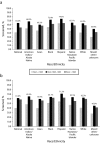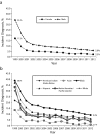Impact of race/ethnicity and gender on HCV screening and prevalence among U.S. veterans in Department of Veterans Affairs Care
- PMID: 25100421
- PMCID: PMC4151890
- DOI: 10.2105/AJPH.2014.302090
Impact of race/ethnicity and gender on HCV screening and prevalence among U.S. veterans in Department of Veterans Affairs Care
Abstract
Objectives: We assessed HCV screening and prevalence among veterans and estimated the potential impact of complete birth cohort screening, accounting for the disparate HCV disease burden by race/ethnicity and gender.
Methods: We used the Department of Veterans Affairs (VA) Corporate Data Warehouse to identify birth dates, gender, race/ethnicity, and laboratory tests for veterans with at least 1 VA outpatient visit in 2012. We calculated HCV screening rates, prevalence, and HCV infection incident diagnosis.
Results: Among 5,499,743 veterans, 54.7% had HCV screening through the VA. In more than 2.9 million veterans screened, HCV prevalence was 6.1% overall and highest among Blacks (11.8%), particularly Black men born in 1945 to 1965 (17.7%). HCV infection incident diagnosis in 2012 was 5.9% for men and 2.3% for women. An estimated additional 48,928 male veterans, including 12,291 Black men, and 1484 female veterans would potentially be identified as HCV infected with full birth cohort screening.
Conclusions: HCV prevalence was markedly elevated among veterans born in 1945 to 1965, with substantial variation by race/ethnicity and gender. Full adoption of birth cohort screening may reveal substantial numbers of veterans with previously unknown HCV infection.
Figures



References
-
- Smith BD, Morgan RL, Beckett GA et al. Recommendations for the identification of chronic hepatitis C virus infection among persons born during 1945–1965. MMWR Recomm Rep. 2012;61(RR-4):1–32. - PubMed
-
- Armstrong GL, Wasley A, Simard EP, McQuillan GM, Kuhnert WL, Alter MJ. The prevalence of hepatitis C virus infection in the United States, 1999 through 2002. Ann Intern Med. 2006;144(10):705–714. - PubMed
-
- Roblin DW, Smith BD, Weinbaum CM, Sabin ME. HCV screening practices and prevalence in an MCO, 2000–2007. Am J Manag Care. 2011;17(8):548–555. - PubMed
-
- Ly KN, Xing J, Klevens RM, Jiles RB, Ward JW, Holmberg SD. The increasing burden of mortality from viral hepatitis in the United States between 1999 and 2007. Ann Intern Med. 2012;156(4):271–278. - PubMed
MeSH terms
LinkOut - more resources
Full Text Sources
Other Literature Sources
Medical

